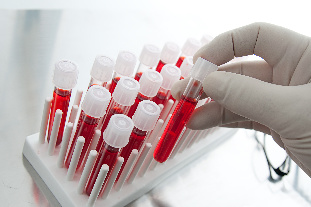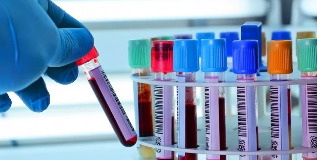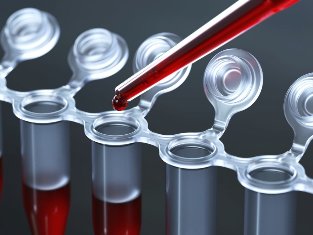Analysis of the blood parasites — a mandatory procedure for all those who work in the field of health care, schools, animals, or intend to visit educational institutions. Unlike studies of cala, modern blood tests to helminths provide a more accurate result, give the opportunity to assess the degree of infestation and to track the effectiveness of the treatment. Surveys are conducted of this type in a hurry and do not require a lot of time to decipher.

When and who needs blood tests in the bot?
The sad medical statistics indicates that approximately for every 3 persons to the problem of helminth today is urgent. Appliances, means of transport, offices and schools, washed the vegetables and the fruit, the handshake — all these habitual for each adult and a child business and become the main source of infection by parasites. Even if the symptoms do not manifest immediately, in every case the parasites very negative impact on the human body: causing deterioration of the appetite, promote the development of allergies, sore body damaged, bad digestion, they are sometimes able to cause death. Having said this, it is necessary to pass to parasites, the analysis of each person (preferably every year).
It is not possible to delay an examination, if you have specific helminthiasis symptoms of error:
- sudden weight loss;
- hives;
- frequent nausea;
- aversion to food;
- the sharp decrease in the hemoglobin;
- irritability, sleeplessness in children.
In addition, it can be defined as a group of people, that necessarily every 6-8 months should control the blood. These, in particular, are:
- the people who live in areas with frequent flash helminthiasis;
- those who work in educational institutions and have to do with small children;
- health-care workers;
- all employees of catering;
- people who work with animals, and even members of their families, veterinarians, workers of the plants of the flesh, the shepherds, the farmers, the workers of the circus and the zoo, etc.).
In addition, a blood test for worms must support all of the children of preschool and school age, which soon should go to school, and cups. Explore the blood parasites must be pregnant, the children on the eve of vaccination. In addition, repeated the analysis, it is worth taking after you have crossed the course of treatment against parasites.
ELISA as one of the most effective methods of diagnosis

The most popular and authentic analysis of today's experts call the elisa analysis of the blood parasites. The main goal of this accuracy, the method and lab — to locate in the blood of antibodies to a particular type of parasites. The immunoglobulin (so-called antibodies) are a natural reaction of the immune system, and have the aim of neutralizing the negative of the agent.
An accurate diagnosis, and to understand the intensity with which the progress of the disease, parasites, how long does it last, the team is managed with the help of 3 different types of immunoglobulins:
- Class A. Detected in the blood of a child or an adult after about 2-4 weeks after infection. With almost 80% of them are in the mucous membranes, and only 20% remains in the blood. After the treatment with immunoglobulin class, And may be present not more than a month. If you repeat the analysis on parasites of new detects, and then, the disease is passed in the chronic form.
- M-class the More quickly react to the presence of a parasite. In the blood found already at day 5 after infection. However, until they are required — 2 months, and then gradually eliminated. Thanks to this indicator, the doctor can conclude about the presence of helminthiasis in a particular moment.
- Class G. Appear relatively late — after 1 month infestation by helminths. However, they are displayed are more than six months. Their use to understand how much time a person is suffering from helminthiasis.
Compared with other common laboratory techniques, ELISA has a number of advantages, in particular:
- high precision;
- the ability to determine the stage of the disease;
- versatility;
- the possibility of using for the mass examination of the population;
- suitable for adults and children.
Enzyme-linked immunosorbent assay should be used for the identification of these types of helminthiasis, such as:
- giardiasis;
- trichinosis;
- leishmaniasis;
- ascariasis;
- cysticercosis;
- opisthorchiasis;
- echinococcosis and other.
Gemo scan to identify parasites

Gemo scan — one of the most modern analysis on the parasites in children and adults. With her help, manages to reveal the following:
- a particular type of parasite;
- the structure and the number of white blood cells;
- the number of red blood cells;
- the degree of viscosity of the blood;
- the state of the immune system;
- the presence of fungi and viruses.
Unlike ELISA, gemo scan provides the fence just a few drops of blood from your finger. The liquid is placed on the sterile glass, and then carefully examined under a microscope. The number of increases reaches 1800-2000 time. Not need any further treatment (use of enzymes, dyes, draining, etc.). The modern clinical the image is displayed on the monitor, but because the patient has the opportunity to observe the research process, to verify the presence of fungi and worms. Shocking can become the image of the larvae of parasites. If necessary, you run a photo or a video search.
This is a fast method, because the information on your state of health, the patient can learn already after 10-15 minutes.
It is worth mentioning that as a method of identification of parasites was troubled the scan is not actually used. The fact is that the human body can accommodate different types of parasites with a different place of location. Not in every case, the migration of the larvae in the blood. Suspect the presence of helminths allows a reduced number of red blood cells, as well as some parasites feed on blood and nutrients), the increase in the number of white blood cells (indicates the struggle of the body with a parasite), dense plasma.
Other methods of diagnosis
If with method 1 to reveal the bot fails, the doctor will recommend further laboratory studies:
- Serological. Also refers to the immunological options, such as ELISA. However, unlike the latter, the former has the purpose of exploring is not the blood and serum. To obtain the information, the physician needs to use a reaction between antibodies and antigens. Hiv is not performed for all types of worms, but just what the doctor suspects. If in the body of a man is a parasite, an expert will notice a clear answer.
- PCR-diagnosis. Does not give the possibility to understand the stage of development of infestations by helminths, and is not recommended when establishing all types of parasites. With its help you can understand only if they are present in the human body simple helminths. The main task of the laboratory in this case — the search of DNA and RNA parasite. When you do not play any role, it will be a parasite alive or dead. Donate for research, there is the possibility of any material, in particular, urine, blood or feces. For greater reliability, this analysis may give up a couple of times.
- Vegetative a test of resonance. The method is based on the discovery of the resonance between the human body and the medication. As the last act supports various computer types of worms. All the data of the frequency of each type of pests were recorded by the researchers already in 1989, the PMA (as you call this method) can be carried out only in laboratory conditions, and gives the possibility to identify in which state is the immune system of a person in a given period of time. So, with the help of the PMA, the doctor can understand if you are suffering from the body from allergies, if toxic, bacterial, parasitic effect or not.
- A detailed analysis of the blood. Overestimated or, on the contrary, sober hemoglobin, decreased number of red blood cells, increase in the number of eosinophils — here are the main signs that allow to suspect the presence of a parasite in the human body.

How to prepare for the search, and how to decipher the results?
Characteristics of the analysis depend directly on the type of method you need to use, and the presence of some types of parasites is suspected. As a general rule, the withdrawal of blood made by vienna, and in some cases (gemo scan) of a finger. It is sufficient to only 10-15 ml of blood, to establish the diagnosis.
To obtain the maximum of reliable information, it is necessary to observe certain rules of delivery of clinical analysis:
- The day before the blood collection, the patient should not consume too much salty, fatty foods (because it can change the level of white blood cells); the products that can cause allergies — citrus honey (increase the level of eosinophils, which has also placed when helminthiasis); foods rich in essential oils — garlic, onion, ginger (affect the activity of parasites).
- Better to take the material on an empty stomach. Animals in a small amount of clean water.
- Necessarily inform your doctor about the medications that have been used in the course of the last 2 weeks.
- It is not advisable for a couple of days before the test to use any physiotherapy (including chest x-ray, ULTRASOUND, x-ray).
- At least one week prior to blood sampling from the take-away of alcoholic beverages and the funds, which contain a large concentration of ethyl alcohol.
- From the smoke need to give up at least 2 hours before the test.
If strong helminthiasis suffered pregnant, the examination requested and the newborn. The blood is drawn from the umbilical cord or the placenta.
For the execution of studies, usually enough for 2-3 days. A little more time (up to 5 days) will have to spend in the case where you run the package, immunological research on different types of parasites.

Interpretation has to do only a specialist. The easiest way to interpretations remain gemo scanning, and PCR-diagnosis. They are both identified pest or larvae, or not.
More difficult is the situation with a method that should be called ELISA. The doctor is required to consider the immunoglobulins once in 3 groups. So, the acute form of the disease you can tell if it will go the combination of: immunoglobulins of the M class positive and class a or class G may be positive or negative. Of the chronic form data refer to: immunoglobulin of the M class are not lacking, but the E-class and G may be positive or negative.
In this case, if any of the above elements of analysis showed a positive result, pull the treatment of helminthiasis not worth the effort. After the full, of a designated medical doctor of the treatment is required for the delivery of analysis, but to do so they need about 2-3 months after the intake of drugs. Not knowing what kind of exams you need to deliver, it is best to consult a doctor-a psychologist, a gastroenterologist or other health professionals.



































